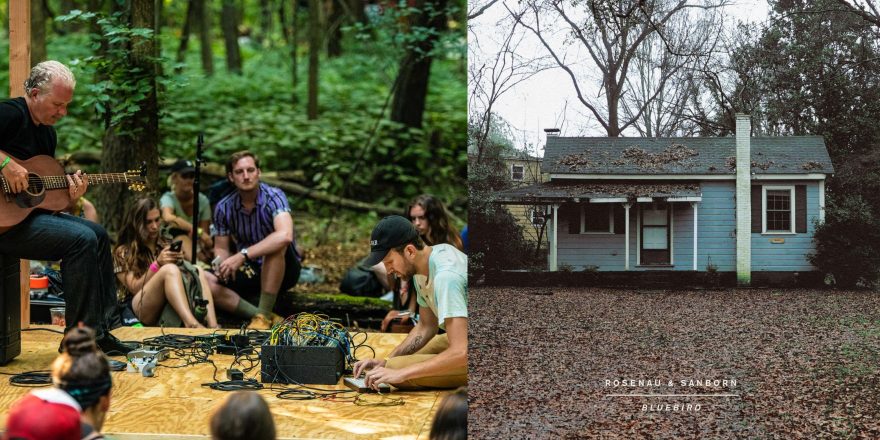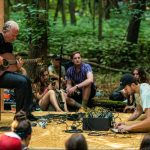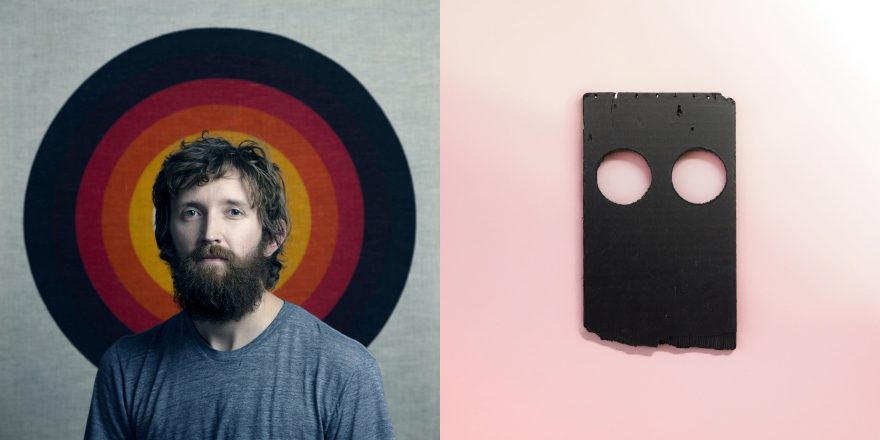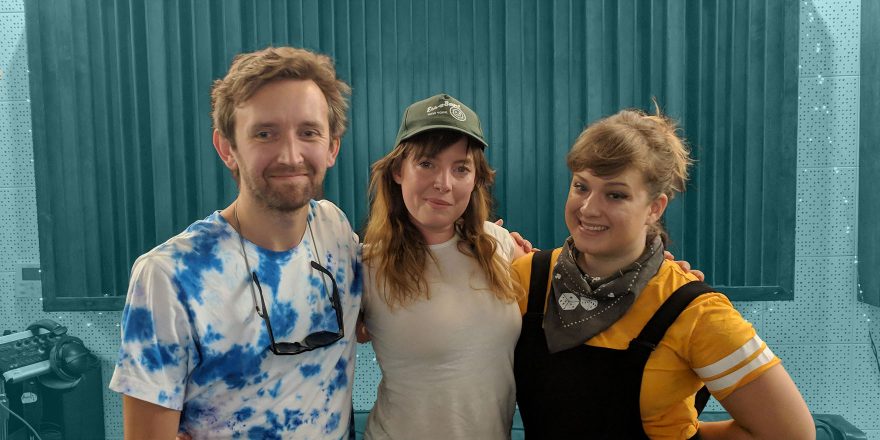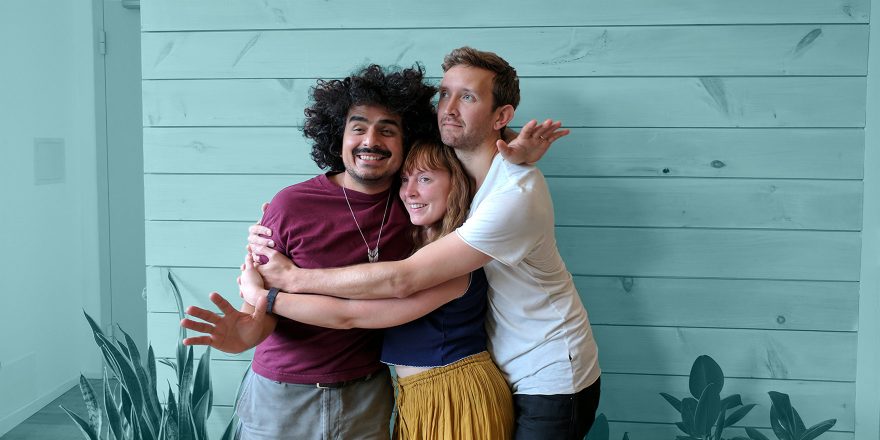Chris Rosenau and Nick Sanborn are old friends who’ve been in a ton of bands — most notably of late Volcano Choir and Sylvan Esso — and who are also gifted improvisers. At the very first Eaux Claires festival, the duo played an impromptu set that led to further collaborations and now, four years later, a debut album. Bluebird was recorded in beautiful Durham, North Carolina, with the studio doors open to nature. Here, Rosenau and Sanborn give us their thoughts on the songs.
—Josh Modell, Talkhouse Executive Editor
“Gentleguy”
Nick Sanborn: This was the second piece we wrote during the session, and it was born from listening back to the first recordings we made — realizing that we were trying too hard in some ways and that our favorite parts of what we had done initially were the spaces between the musical moments, the sounds of the woods and cars and weather drifting in through a window. We immediately went back into the room and opened everything up, even the front door, and played in a way to purposefully leave plenty of room, to allow for a distinct sense of place and time. Even the setup was simplified — just Chris playing a melody, me sampling his guitar and playing him back to himself as a kind of reflected duet.
Chris Rosenau: I was looking for an easy way, without switching tuning again, to change things up a bit. I put a capo pretty high up the neck (for me) and started noodling around with the little part that we ended up landing on. We set things up such that Nick was able to process my guitar signal through his modular rig at any point throughout the session. He started live processing my guitar in a really sparse way. Between the starkness of the part I was playing, the sparse nature of his processing, and the stillness of the evening, it was sounding pretty good to us. We hit record and that was it. As with all of the titles on the final record, “Gentleguy” was the working title we used for the file to just distinguish it from the others for ourselves. It is a pretty gentle guy.
“Saturday”
Nick: “Saturday” was a piece that came around just as Chris and I had figured out this logistical problem we had been trying to solve — we wanted our instruments to fully interact with each other, so it wasn’t just the two of us playing in the room but each of us playing the other person’s instrument as well. It was really complicated and a perfect problem for two people who love hanging out and having nerdy talks about gear all afternoon, but when we finally got it working so that Chris’ loops could kind of “conduct” my whole rig this piece just showed up out of nowhere. I think we only played it twice, and I’m pretty sure the second take is the one that made it, but it just exploded out of the joy of this idea working. You can even hear me saying at the end of the take that I think I screwed something up, because we knew we didn’t want to do it too many times, we wanted it to just be what it was, right in that moment.
Chris: This is the first one Nick and I recorded during the session. We had been working on the technical problem of getting our two non-laptop-based rigs to be able to sync up with each other ever since the first time we improvised together. After a couple of tries over a couple of years, Nick finally figured out a reproducible and effective way to achieve this. Worked like a charm. I had been nutsing around with the riffs in the song that morning before we got together, so after we got everything synced up, we both started playing around those riffs, and the whole thing came together. We might have run it once or twice tops before we recorded this version that ended up on the record.
“Last One”
Nick: As is probably obvious from the title, this was the last thing we made before packing up. The whole session had us both in such a high and we knew we had very little time left, but we really wanted to get one more piece together. That energy translated directly into “Last One”’s sense of propulsion for me, it’s like a rock picking up speed as it rolls down a hill. We didn’t even do a second take, we didn’t have time.
“Sharon”
Chris: This one started with Nick finding Sharon van Etten’s voice in his rig from a remix he had done of “Our Love.” He started playing around with processing it, and we really liked what was happening. I landed on the simple, stark chord progression that appears on the record, and we hit record. This one, like most of the rest, materialized quickly as we were playing around. The final guitar vamp is actually the only thing played from one of our previous sets that appears on the record. It’s from one of the improv sets we had done at one of the Eaux Claires fests. I remembered liking that line when it happened when we played at Eaux Claires, and somehow thought about it as we were recording it.
Nick: “Sharon” showed up at about the halfway point in making this record and it was the first moment I felt like I understood what we were actually making. I had been subtly using my own voice on most of what we had recorded, but it wasn’t until I used someone else’s voice that I started to really understand the width of space a human voice could inhabit in this context; how Sharon’s voice could ground the piece in a certain humanity, how the act of sampling itself can elicit a sense of comfort, knowing, or nostalgia.
“Rainy Dog”
Nick: Our old studio where we recorded this was just a run down one-bedroom house in the woods, which was great in so many ways but a real hassle in a lot of others. Pretty much right after we moved in the city started redoing the street, so everything we recorded there was filled with the sounds of trucks beeping as they backed up and jackhammering. On the odd hour they weren’t working we still had to deal with our weird neighbors who had these two lovable but very aggressive dogs who would bark at the slightest provocation: a squirrel, a bird landing in the nearby scum pond, a car starting within a half-mile radius. On this afternoon the black lab just would not give it a rest, and we just went with it. Chris has this beautiful idea for a chord progression, and I suggested that I sample him ahead of time and let him join in with the sampler, reversing the usual temporal relationship. That led to this serendipitous moment of peace, with the rain finally dying off and the dog either joining in with us, complaining about us, or fixated on another perceived threat, we never knew which.
(Photo Credit: left, Graham Tolbert)


